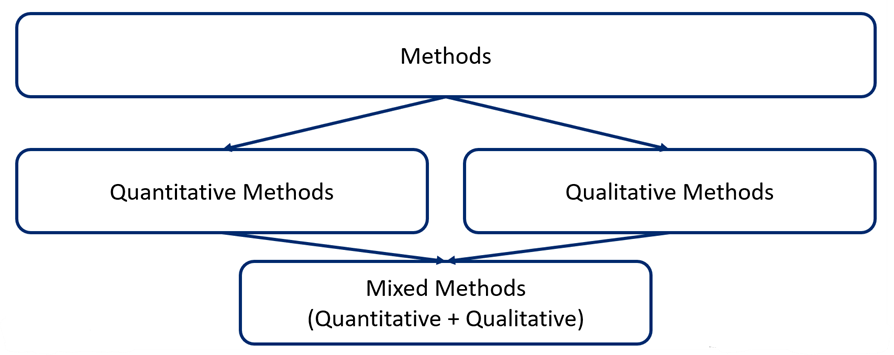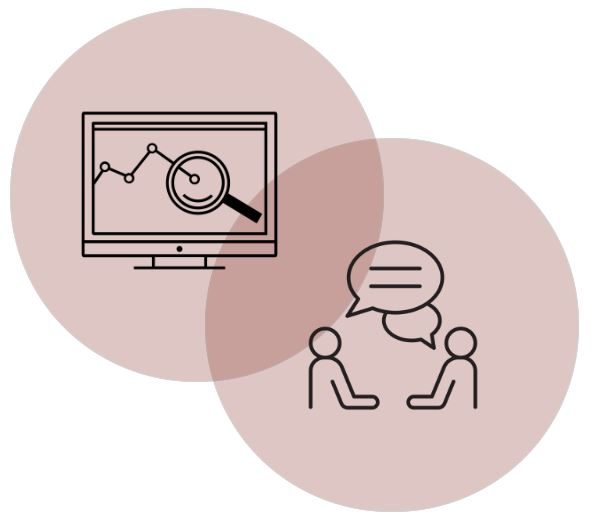There are three general types of research methods:
To learn more, check out our glossary of research terms (downloadable PDF).
Above: Diagram of research method types
Main differences between qualitative and quantitative research:
| Quantitative | Qualitative | |
|---|---|---|
| Objective | To measure a phenomenon | To understand a phenomenon |
| Questions | How many? Questions with yes/no answers | What? How? Why? |
| Data | Numbers, questionnaires, survey, documents | Words, images, sound(s), interviews, observations |
Quantitative research
Quantitative research is useful for studying measurable phenomena. It tries to explain phenomena by collecting data, and analyze them using mathematical methods, especially statistics.
- How many cases of a disease exist in a population?
- What proportion of people with a disease survives 5 years after the diagnosis?
- Does a new treatment decrease the symptoms of a disease compared to the traditional
Goals of quantitative research
Generalization of results
The central goal of quantitative research is the generalization of findings. It is often impossible to study a whole population. Instead, a representative sample of that population is studied. Generalization means that the researchers will extend the results found from a sample to the whole population.
Hypothesis testing
Quantitative research also allows to study hypotheses using statistical tests. For example, a researcher can be interested in comparing the following two hypotheses:
- The influenza vaccine reduces the number of hospitalizations per year, and
- The influenza vaccine does not reduce the number of hospitalizations per year
To test these hypotheses, a quantitative study can be performed to compare the number of elderly people hospitalized among those who have been vaccinated and those who have not been vaccinated. Statistical tests are used to compare groups. It will tell us the probability of the observed results being due to chance or not.
It is very important to note that it is always possible to obtain incorrect “results” in quantitative research. A methodological error can very easily lead to erroneous conclusions. Rigour of the methods is particularly important.
Types of quantitative health research
| Field | Study | Example |
|---|---|---|
| Biomedical science | To study living organisms, their responses to disease processes and therapies | Does the new antibiotic kill more germs than the old one? |
| Clinical research | To study the efficacy and safety of treatments and diagnostic products | Does the new antibiotic treat a disease faster compared to traditional treatment? |
| Public health research | To study disease prevention and health promotion | Does the use of the new antibiotic reduce the number of hospitalizations? |
| Health services research | To answer health services questions | Did doctors prescribe the new antibiotic to patients in need? |
Quantitative study designs
There are two general types of study designs within quantitative methods:
- Experimental
- Observational
| Type | Study design | Example |
|---|---|---|
| Experimental | Randomized controlled trial | Researchers determine, through a controlled process, the exposure for each individual (clinical trial) or community (community trial). They then track the individuals or communities over time to detect the effects of the exposure. Participants are allocated at random to the intervention or control groups. |
| Observational | Cohort (longitudinal) | Researchers record whether each study subject is exposed or not. They then track the subjects to see if they develop the disease being studied. |
| Case-control study | Researchers enroll a group of people with the disease (cases) and a group without the disease (controls). They then compare previous exposures to different factors between the two groups. | |
| Cross-sectional study | Researchers enroll a sample of people from a population and their exposures and health outcomes are measured simultaneously at a specific point in time. | |
| Ecological (population-based) | Researchers measure disease rates and different determinants for each unit (each population), and the relationships between disease rates and determinants are examined. |
Statistics in health research
Statistics is the analysis and interpretation of quantifiable data expressed as an amount, quantity, or numerical value.
Two types of statistics are often used in health research:
Descriptive statistics
- describe, organize, summarize and present variables and numerical data.
- do not allow to make conclusions beyond the analyzed data or reach conclusions regarding a hypothesis.
- present the data in a more meaningful way that facilitates interpretation.
Inferential statistics
- allow us to use results from samples to make generalizations about the populations from which the samples were drawn. It is important that the sample accurately represents the population.
Big data and health research
- Big data researchers work with massive sets of anonymized data.
- Rather than relying on representative data samples, data scientists can now rely on the data itself, in all of its granularity, nuance, and detail.
- Artificial intelligence is an example of how to use big data.
- The ability to access large volumes of data is leading to a rapid evolution in the application of artificial intelligence applications.
- Greater access to health databases (anonymized data) (e.g., governments, hospitals, etc.) will enable more accurate and reliable research for patient diagnosis and treatment.
Additional resources
Qualitative research
When to use qualitative research
Qualitative research is not used instead of quantitative research. It allows us to answer questions that cannot be answered with quantitative research. Qualitative data are collected by speaking to people, by observing people and situations, and systematically recording observations (taking notes, photographs, videos, etc.). In this way, qualitative research allows us to gain an in-depth understanding of a phenomenon.
Qualitative data collection
Qualitative data are collected in three main ways:
Interviews
Speaking with people either individually or in groups, recording interviews and transcribing them. These transcriptions become the data that arethen analyzed.
Observations
Observing people and situations, and systematically recording these observations through note taking, photographs, sketches, or videos.
Documents
Collecting documents, such as emails, reports, meeting minutes, or any other document that provides information necessary for answering the research questions.
Transferability
Qualitative research results are not being generalized to larger populations. This is not possible because, among other things, the samples are generally small. The richness of qualitative research is in the level of detail and the depth of the results.
Transferability is the qualitative “equivalent” of generalizability. The objective is to present the results with enough details for the reader to see if they are transferable in their context.
Perspectives and dimensions
Not everyone understands or perceives a phenomenon the same way. Qualitative research allows us to examine the different perceptions of those experiencing the phenomenon.
Construction and deconstruction
In qualitative research, to understand a phenomenon, it is “broken apart” into many “pieces”, which are then put together in new ways. For example, in a qualitative study, researchers would “break apart” transcriptions of interviews into separate categories. This data analysis process is referred to as “coding”.
Mixed methods research
What are mixed methods
Mixed method research refers to the combination and integration of qualitative and quantitative methods in the same research study. Integration is a key element of mixed methods research. Integration refers to the point where the qualitative and quantitative components meet in a mixed methods research project.
Note that if a qualitative study appears together with a quantitative study in a research project, it is not necessarily a mixed methods research per se. In other words, mixed methods research is not the simple addition of separate qualitative and quantitative studies.
When to use mixed methods
Mixed methods are used when integrating qualitative and quantitative information is needed to better answer the research questions. Mixed methods may be chosen when there is a need:
- To interpret quantitative results
- To statistically generalize qualitative results
- To both explore (qualitatively) and to measure (quantitatively) a phenomenon
Advantages and challenges of mixed methods
Advantages
- The strengths of each method type can compensate for the limits of the other.
- Mixed methods research provides a more complete and in-depth understanding of the studied phenomenon than a quantitative or qualitative study alone.
Challenges
- The research process can be complex and require a lot of time and resources.
- Can potentially require additional training and equipment (e.g., specialized software).
Quantitative research will generally provide access to one or more explanations that are more general and give measures, generalizable descriptions, general trends (e.g., statistical analyses on a large group of people).
Qualitative research will generally provide access to a more in-depth understanding of complex phenomena in a specific context (e.g., individual interviews to understand the perspective of members of a social group).
By combining the two, mixed methods research can potentially compensate for the limitations of each method in understanding a phenomenon in both its general and specific aspects.
Mixed methods allow a more complete and in-depth understanding of the phenomenon under study than a quantitative or qualitative approach used alone. The idea here is that by combining and integrating the strengths of qualitative and quantitative methods, it will be possible to better explain the complexity of a phenomenon. However, this requires researchers or research teams to have a good understanding of both qualitative and quantitative methods.
Additional resources
- What is mixed methods research?: a video from John Creswell
Tell us what you think of this page
"*" indicates required fields








